Easy-does-it main dishes
You can savor the flavors of awesome restaurants serving up Asian fare in every corner of the Triangle. Korean barbecue, Japanese sushi, Chinese noodle dishes or yummy eats from another country may inspire you to try your hand at the cuisine in your own kitchen. Here are recipes from five books that’ll provide a smooth entrée into the world of Asian cookery.
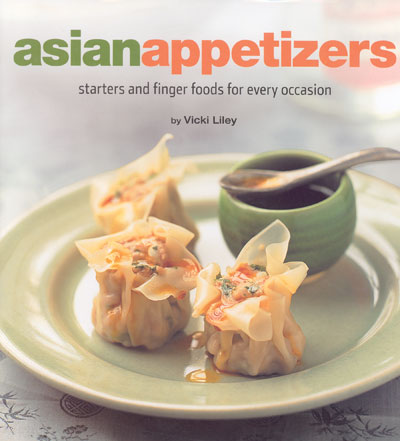 Asian Appetizers:
Asian Appetizers:
starters and finger foods for every occasion
by Vicki Liley
Published by Periplus Editions
Steamed Shrimp and Spinach Dumplings
These beautiful, translucent dumplings have a delicate texture that nearly melts in your mouth. Once you’ve mastered the basic technique of making steamed dumplings, try different filling combinations. In place of spinach, for example, try another quick-cooking green, such as watercress or Swiss chard.
8 ounces fresh shrimp or prawns, peeled and deveined, finely chopped 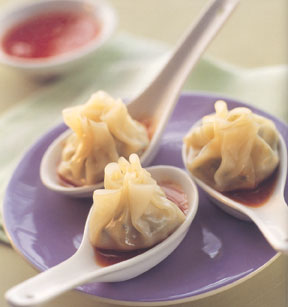
1 tablespoon oil
2 cloves garlic, crushed
1 cup spinach leaves, washed and finely sliced
2 tablespoons canned water chestnuts, finely chopped
2 green onions (scallions), finely chopped
1 tablespoon soy sauce
16 fresh or frozen wonton wrappers
Soy sauce or Thai sweet chili sauce, for dipping
Heat the oil in a wok or frying pan over medium heat. Add the garlic and fry until aromatic, about 1 minute. Stir in the spinach and chopped shrimp and stir-fry until the shrimp change color, about 2 minutes. Remove from the heat and allow to cool. Add the water chestnuts, green onions and soy sauce to the shrimp and spinach mixture. Mix until well combined.
Place the wonton wrappers on a clean work surface and cover with a damp kitchen towel. Working with one wrapper at a time, lay the wrapper on the work surface and place 1 teaspoon of the shrimp filling in the middle. Brush the edges of the wonton wrapper with water (use a pastry brush or a finger). Gather the dumpling corners together and twist to seal. Set aside and cover with plastic wrap. Repeat with the remaining wonton wrappers and shrimp filling.
Place the dumplings in a steamer or steamer basket lined with parchment (baking) paper, leaving some space for steam to circulate efficiently. Partially fill a wok or pot with water (steamer or basket should not touch the water) and bring to a rapid boil. Place the steamer over the boiling water and cover. Steam for 12 minutes, adding more water to the wok if necessary. Lift the steamer off the wok and carefully remove the dumplings.
Serve warm with the Thai sweet chili sauce or soy sauce for dipping.
Makes: 16 dumplings
Note: Dumpling filling can be prepared 2 hours ahead. Keep covered and refrigerated.
Baked Vegetable Samosas with Mint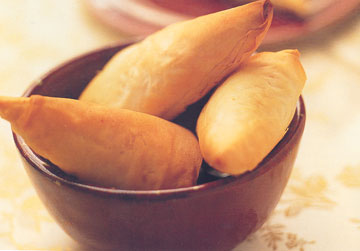
Called turnovers in the West, this Indian version is made with a signature spice and fresh herb combination.
3 large potatoes, peeled and chopped
2/3 cup cooked green peas
1 teaspoon cumin seeds
1-2 green finger-length chilies, deseeded and finely chopped
1/2 red onion, finely chopped
3 tablespoons chopped fresh coriander leaves (cilantro)
2 tablespoons chopped fresh mint leaves
1/3 cup fresh lemon juice
12 sheets frozen filo pastry, thawed
1/3 cup oil
Preheat oven to 400 degrees. Line a baking tray with parchment paper. Cook the potatoes in salted boiling water until tender, about 8 minutes. Drain and mash. In a medium bowl, combine the mashed potatoes with the rest of the ingredients. Stir until well combined.
Place 1 sheet of the filo pastry on a clean work surface (keep remaining filo covered with a damp cloth). Brush lightly with oil. Fold in half lengthwise. Brush again with oil. Place 1 heaping tablespoonful of the potato filling at one end of the pastry strip. Fold the corner over the filling to make a triangle. Continue folding in the same fashion to make a triangular package. Place on the prepared pan. Brush with oil. Repeat to make more samosas. Bake for 15-20 minutes or until golden and crisp. Serve hot.
Smoked Salmon and Cream Cheese Sushi
This pretty inside-out roll with smoked salmon is a wonderfully inventive western twist on sushi.
1 nori seaweed sheet
1 cup cooked Sushi Rice (see recipe below)
1 teaspoon wasabi paste or English mustard
2 tablespoons cream cheese
4 slices smoked salmon
4 asparagus spears, blanched and chilled
4 fresh dill sprigs, minced
Soy sauce, for dipping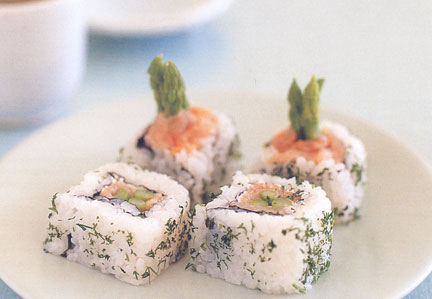
Cover a sushi mat with plastic wrap. Place nori on the plastic, glossy side down. Spread the Sushi Rice over the nori, leaving a 3/4-inch uncovered strip of nori on side farthest from you. Holding the surface of the Rice with one hand, turn over the rice and nori so that the rice is on the plastic and nori is on top. Using your index finger, smear the wasabi and cream cheese over the nori.
Arrange 2 salmon slices and 2 asparagus spears in the center, allowing the asparagus to poke out of the nori at both ends. Roll the sushi to enclose the fillings but leave one-fourth of the nori visible at the end farthest from you. Lift up the mat and roll forward to join the nori edges. Press gently to form into a square shape.
Unroll the mat, remove the plastic and transfer roll to a cutting board. Wipe a sharp knife, cut the roll into 4 pieces. Coat the rolls with dill. Place the rolls on plates and serve with soy sauce.
Sushi Rice
The first step in making sushi is to prepare the rice. It is well worth buying an electric rice cooker, as it reduces the process of cooking the rice to the simple press of a button. After cooking the rice, you will need a wooden sushi bowl and rice paddle or a large non-metallic mixing bowl or salad bowl and a wooden spatula to make the sushi rice. Do not use metallic utensils as the vinegar used to make sushi rice can react with metal and cause an unpleasant taste.
1-1/2 cups uncooked short-grain Japanese rice
1-1/2 cups water
1 tablespoon mirin or sake
Vinegar Dressing:
4 tablespoons rice vinegar
2 tablespoons sugar
1 teaspoon salt
Using a measuring cup, measure the required amount of rice and place it into a bowl that holds at least twice the volume of the rice.
Wash the rice by adding water to the bowl. Stir the rice briskly for about 10 seconds, then cover it with your hand and carefully drain away the milky water. Repeat this process until the water runs clear. Transfer the rice to a sieve to drain.
Set aside for 30 minutes.
Place all the ingredients and the washed rice in the electric rice cooker and allow the rice to soak for 20 to 30 minutes – the rice grains will absorb moisture and start to swell. Then switch on the rice cooker.
Prepare the Vinegar Dressing by combining the rice vinegar, sugar and salt in a small saucepan and heat over low heat, stirring occasionally, until the sugar is dissolved. Remove from the heat and set aside to cool. To stop the vinegar from distilling off, set the bowl of vinegar in a cold water bath to speed up the cooling process.
Wipe the inside of a wooden bowl with a damp cloth to moisten it slightly and moisten the rice paddle with water. Transfer the cooked rice to the wooden bowl while it is still hot using the rice paddle.
Slowly pour the Vinegar Dressing evenly over the cooked rice, a little at a time and mix it into the rice with quick cutting strokes (not stirring) of the paddle across the bowl to separate the rice grains and spread the rice out. At the same time, fan the rice to cool it quickly by using a hand-held fan or an electric fan set at low. This will give a glossy finish to the rice. Continue until the rice is lukewarm. It should take about 10 minutes to mix in the sushi rice vinegar sauce thoroughly.
Spread a damp muslin cloth or kitchen towel over the rice to keep it moist and cover the bowl until ready to use.
NOTE: If not using an electric rice cooker, place all the ingredients in a heavy saucepan. Soak the rice for 20-30 minutes, then bring to a boil over medium heat. Boil the rice for 1-2 minutes, then cover the pain tightly, reduce the heat to low and simmer for 10-20 minutes until cooked. Turn off the heat and allow the cooked rice to steam for 20 minutes before removing the lid.
Do not refrigerate cooked Sushi Rice, as this causes the gluten to congeal and reduces the stickiness of the rice, making it hard to shape properly, as well as reducing the flavor. Prepared Sushi Rice will not keep until the next day.
 Healthy and Simple Asian Recipes
Healthy and Simple Asian Recipes
for delicious everyday meals
Recipes by various chefs
Published by Periplus Editions
Tofu With Ginger and Black Bean Sauce
There are probably as many ways to prepare hong shao (red-braised) tofu, as there are cooks in China. This traditional method of cooking tofu, which by itself is a very bland food, allows the manifold flavors of the seasoning and sauce to penetrate the tofu, rendering this potent source of vegetable protein into a delicious dish. Each time you cook this dish, try a slightly different blend of flavors and proportions until you discover the style that best suits your taste.
5-6 dried black Chinese mushrooms
1 cake (10 ounces) firm tofu
3 tablespoons oil
1-2 dried red chilies, cut in half and deseeded (optional)
4-5 large cloves garlic, smashed
6 slices ginger
1 whole star anise pod (optional)
6 green onions (scallions), cut into sections
Sauce:
3 tablespoons soy sauce
2 tablespoons rice wine
1 tablespoon sesame oil
1 tablespoon sugar
1 tablespoon black or yellow bean paste
1/2 teaspoon ground black pepper
1 teaspoon cornstarch dissolved in 1/2 cup water (or use chicken stock)
Soak the mushrooms in warm water for about 20 minutes to soften, then drain. Remove and discard the stems, cut the caps in half and set aside.
Cut the tofu into bite-sized cubes. Place in a colander to drain.
Combine all the sauce ingredients in a bowl and set aside.
Heat the oil in a wok or large skillet until hot, but not smoking. Add the chilies (if using), then the tofu, turning gently with a spatula until all the pieces are coated with oil and shaking the pan occasionally to prevent sticking. Fry until the tofu just begins to turn yellow but is not brown or crispy.
Add the mushrooms, garlic, ginger, star anise and half the green onions, and stir-fry gently for 1 to 2 minutes.
Add the sauce and stir carefully to blend. Cover the wok, lower the heat and braise for 5 to 6 minutes, adding a few tablespoons of water if the sauce becomes too dry.
Add the remaining green onions to the wok and transfer to a serving dish.
Makes: 4 servings
Tofu and Mushroom Lettuce Cups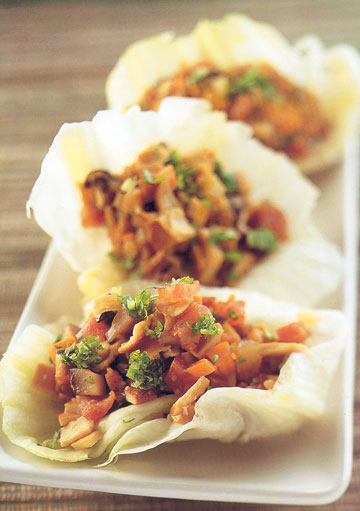
1 cake (10 ounces) firm tofu, finely diced
1/4 teaspoon salt
1/2 cup oil
1 teaspoon finely chopped shallots
1 teaspoon finely chopped garlic
4 tablespoons dried shrimp, soaked and finely chopped (see Note below)
2 sweet dried Chinese sausages or lap cheong, diced (see Note below)
2 water chestnuts, peeled and diced
4 fresh black Chinese mushrooms, diced
1/4 cup diced carrot
1/4 cup diced bell pepper
1 small chili pepper, deseeded and chopped
1 teaspoon rice wine
1/4 cup chicken or vegetable stock
1 tablespoon oyster sauce
1-2 teaspoons soy sauce
1 teaspoon sugar
1/4 teaspoon ground black pepper
1 teaspoon sesame oil
Several large lettuce leaves, torn to make serving cups
2 tablespoons chopped fresh coriander leaves (cilantro), to garnish
Sprinkle the diced tofu with the salt.
Heat the oil in a wok and deep-fry the tofu until golden brown, 2-3 minutes. Remove the tofu and drain.
Discard all but 1 tablespoon of the oil in the wok and stir-fry the shallots and garlic until fragrant, about 1 minute. Stir in the dried shrimp, Chinese sausages, water chestnuts, mushrooms and carrot, then stir-fry for 2 minutes.
Add the tofu, bell pepper and chili. Pour in the wine, then add the chicken or vegetable stock and the remaining ingredients. Stir briskly until evenly mixed. Divide among the lettuce leaves and serve garnished with the chopped coriander leaves.
NOTE: Sweet dried Chinese sausages (lap cheong) are perfumed with rose-flavored wine. Generally sold in pairs, these sausages keep without refrigeration and are normally sliced and cooked with other ingredients rather than being eaten on their own. They should not be eaten raw. Substitute any sweet, dried sausage or meat jerkey.
NOTE: Dried shrimp are sold in plastic packets or in bins in Asian markets. Choose dried shrimp that are pink in color and soak them in water to soften before use.
Makes 2-3 servings.
Healthy Brown Rice Congee
Millet is the oldest grain on record as a staple cereal crop in China. Although it is rarely consumed any more in the West, millet remains one of the most beneficial of all grains for human health. It is also very easy to digest and it is the only grain that alkalizes rather than acidifies the stomach. Millet lends itself best to the preparation of congee and in this recipe it is combined with the hearty flavor and chewy texture of brown rice.
1 cup uncooked brown rice
16 cups water
1/2 cup uncooked millet
1 teaspoon salt
Seasoning:
1 teaspoon sesame oil
1/2 teaspoon ground black pepper
1/2 teaspoon salt
1 green onion (scallion), minced
Wash and rinse the brown rice well, then place in a large pot and add the water. Set aside to soak for 3 to 5 hours, or overnight.
Bring the water and rice to a boil over high heat, then add the millet and salt. When the water comes to a full boil, reduce the heat to medium-low, cover partially with a lid to allow steam to escape and simmer until it reaches the consistency of porridge, about 1-1/4 hours. Stir occasionally to prevent sticking and add water as needed if it gets too dry.
Turn off the heat and leave the pot covered until ready to serve.
Mix the Seasoning ingredients together and divide among individual serving bowls, spoon the congee on top and stir to blend the flavors.
Makes 4 servings.
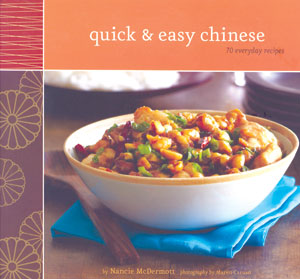 Quick & Easy Chinese:
Quick & Easy Chinese:
70 everyday recipes
by Nancie McDermott
Published by Chronicle Books
Halibut Steamed With Fresh Ginger
Cantonese cuisine focuses on fresh ingredients with a particular appreciation for seafood, and delicacy is a hallmark of many classic Chinese dishes. Banquets and family feasts often include a whole flounder, steamed and seasoned with fresh ginger, green onions and an aromatic dollop of Asian sesame oil. I love this weeknight version, using halibut, snapper, cod or any other meaty fillets. Use a standard Asian steamer if you have one or improvise a steaming setup. My instructions here are lengthy because the process for steaming fish is unfamiliar to many cooks, but all the steps are simple and the resulting dish is delicious.
2 tablespoons soy sauce
2 tablespoons dry sherry or Shaoxing rice wine
2 teaspoons Asian sesame oil
2 tablespoons vegetable oil
3/4 pound halibut fillets, or another meaty fish such as cod or snapper
1/2 teaspoon salt
2 tablespoons shredded fresh ginger
3 tablespoons thinly sliced green onion
In a small bowl, combine the soy sauce, sherry and sesame oil, and stir well. Place it by the stove for preparing the sauce right after cooking. Put the vegetable oil in a small saucepan or small skillet and place it by the stove as well. Set a serving plate for the fish by the stove, along with a long-handled spatula or V-shaped metal tongs with which to transfer the fish from its cooking plate to its serving plate, where you will add the seasonings.
To use a standard steamer, fill the base of a steamer set or a wok with about 4 inches of water. Place the steamer basket over the water. Set out a plate that will fit inside the steamer basket, on which to place the fish.
Arrange the fish skin side down on the plate. (If you have more than one piece, leave a little space between them.) Sprinkle the salt lightly over the fish. Scatter the ginger over the fish. Put the plate in position inside the basket or on the rack, and bring the steaming water to a rolling boil over high heat.
When the steam is flowing well, adjust the heat to maintain an even steam flow, and cover the steamer basket with its lid. Cook the fish for 10 minutes or until it is done to your liking at the thickest part of the fish. Turn off the heat and leave the fish in the steamer while you heat the oil.
Place the small pan or skillet of oil over medium-high heat. Let it heat up until it is hot but not smoking, about 1 minute. Remove from the heat and keep it handy.
Carefully transfer the fish to a serving plate, leaving any liquid behind. Quickly pour the soy-sauce mixture over the ginger-covered fish, and scatter the green onion on top of the ginger. Slowly pour the hot oil over the top of the fish, expecting a big sizzle and gingery aroma. Serve hot.
Makes: 4 servings
Kung Pao Chicken
This wildly popular dish has a longer ingredients list than many of the recipes in this book, but this is mostly a matter of measuring out the two seasoning mixtures. Once that's done, there's a bit of chopping and then you're ready to cools up a speedy and spectacular dish. To prepare in advance, chop the chicken, stir up the marinade, and mix it with the meat. Cover the bowl and refrigerate it for several hours or as long as overnight. Then mix the sauce, gather the remaining ingredients, and cook. Classic recipes include Szechuan peppercorns, but if you don't have them, it's still a delicious dish.
FOR THE CHICKEN MARINADE
3/4 pound boneless, skinless chicken breast
1 tablespoon soy sauce
1 tablespoon dry sherry or Shaoxing rice wine
1 tablespoon cornstarch
1 teaspoon vegetable oil
FOR THE SAUCE
1 tablespoon soy sauce
1 tablespoon dry sherry or Shaoxing rice wine
1 tablespoon red wine vinegar or Chenkiang vinegar
1 tablespoon sugar
1 teaspoon cornstarch
1 teaspoon salt
FOR COOKING THE CHICKEN
2 tablespoons vegetable oil
5 to 10 small dried hot red chiles or 2 teaspoons red pepper flakes
1 teaspoon Szechuan peppercorns, toasted and crushed (optional)
1 tablespoon coarsely chopped garlic
1 tablespoon finely chopped fresh ginger
1/4 cup coarsely chopped green onion
3/4 cup roasted, salted peanuts
1 teaspoon Asian sesame oil
To prepare the chicken: Chop it into bite-sized chunks, about 1 inch in diameter. In a medium bowl, combine the soy sauce, sherry, cornstarch, and vegetable oil. Stir to mix everything well, and then add the chicken, tossing to coat it evenly. Set aside for 30 minutes to 1 hour, or cover and refrigerate for up to 1 day.
To make the sauce: In a small bowl, combine the soy sauce, sherry, vinegar, sugar, cornstarch and salt. Stir to dissolve the dry ingredients, and mix everything together well.
Prepare the remaining ingredients, and place everything by the stove, along with a serving platter for the finished dish.
To cook the chicken, heat a wok or a large, deep skillet over medium-high heat, and then add the vegetable oil. Swirl to coat the pan, and when it is hot but not smoking, add the chiles. Toss well for about 30 seconds, and then add the Szechuan peppercorns, if using. Cook for about 1 minute, until fragrant and shiny, tossing once or twice.
Scatter in the chicken and let it cook on one side for about 1 minute. Toss well, and then add the garlic, ginger, and green onion. Cook 1 to 2 minutes, tossing now and then, until the chicken has changed color and is cooked through.
Stir the sauce, and add it to the pan. Cook another minute, tossing often, and then add the peanuts and sesame oil. Toss once more, transfer to a serving platter, and serve hot or warm.
Makes 4 servings.
Mu Shu Pork
I adore this northern Chinese-style dish, whether we eat it tucked into Mandarin Pancakes seasoned with a little hoisin sauce or enjoy it as part of a rice-centered meal. Mu shu means "cassia blossom," a delicate yellow flower which is suggested by the puffy chunks of softly scrambled eggs in the dish. This is my weeknight version of the classic dish, in which I've included fresh mushrooms, shredded napa cabbage, and carrots. I've omitted the traditional dried lily buds and cloud ear mushrooms, which require soaking and trimming before cooking.
1/2 pound thinly sliced pork (such as pork shoulder, pork butt or thick-cut pork chops)
2 tablespoons soy sauce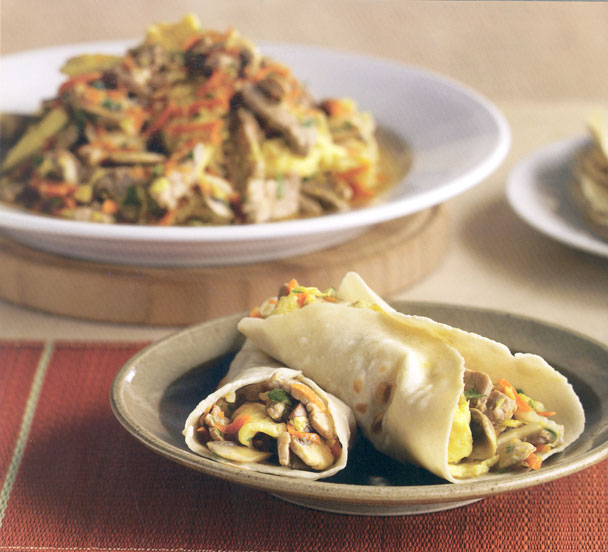
3 tablespoons chicken stock
2 tablespoons dry sherry or Shaoxing rice wine
1 teaspoon salt
1/2 teaspoon sugar
2 tablespoons water
2 teaspoons cornstarch
3 tablespoons vegetable oil
2 large eggs, beaten well
1 tablespoon chopped garlic
2 teaspoons finely chopped fresh ginger
3/4 cup shredded carrots
3/4 cup thinly sliced fresh mushrooms
2 cups shredded napa cabbage or 3 cups baby spinach leaves
2 teaspoons Asian sesame oil
1/4 cup finely chopped green onion
Cut the pork crosswise, against the grain, into thin slices. Stack the slices and cut them lengthwise into shreds. Put the pork in a medium bowl, add the soy sauce, and toss to season it evenly. Set aside for 10 minutes.
In a small bowl, combine the chicken stock, sherry, salt and sugar, and stir to mix everything well. In another small bowl, combine the water and cornstarch and stir to mix evenly, leaving the spoon in the bowl so you can give it a final stir. Place a medium bowl by the stove to hold the eggs after they are scrambled.
Heat a wok or a large, deep skillet over high heat. Add 1 tablespoon of the vegetable oil, and swirl to coat the pan.
Add the eggs, and swirl to spread them out over the surface of the pan. Cook until the edges begin to set, and then gently pull them in and lift them up to expose most of the liquid to the hot pan. Toss gently, scooping and turning to let the eggs cook into soft, moist lumps. Transfer the eggs to the bowl and set aside. (Underdone is better than dry, as it will go back into the pan at the end of cooking.)
Let the pan heat up again, and then add the remaining 2 tablespoons vegetable oil. Swirl to coat the pan. Add the garlic and ginger and toss well until fragrant. Add the pork and spread it out into a single layer. Cook 30 seconds undisturbed, and then toss well.
Add the carrots and mushrooms and toss well. Cook, tossing often, until the pork has changed color, and the carrots and mushrooms are shiny and softening, l to 2 minutes. Add the napa cabbage and cook, tossing often, until it brightens in color and begins to soften, about 1 minute more.
Add the chicken stock mixture and cook, tossing often, until the pork is cooked through and the vegetables are tender but not limp, l to 2 minutes more. Give the cornstarch mixture a good final stir, add it to the pan, and toss well just until the sauce begins to thicken.
Add the sesame oil and green onion, along with the scrambled eggs, and toss gently, just to mix everything well. Transfer to a serving platter and serve hot or warm.
NOTE: Though the pork for this dish is traditionally shredded into thin strips, sliced pork works fine. Instead of button mushrooms, you can use 3 ounces of fresh shiitakes. Cut away and discard the stems, and then cut their caps into thin strips, about 1/4 inch wide, to make about 1 cup.
Makes 4 servings.
 The Korean Table:
The Korean Table:
from barbecue to bibimbap
by Taekyung Chung and Debra Samuels
Published by Tuttle Publishing
Korean Hot Wings
(Dak Gangjung)
Just like the best French fries, these hot wings are twice fried. Double frying makes the skin extra crispy, and a lip-tingling glaze makes them irresistible. Like any dish fried in good oil, if the oil is hot enough the food is not greasy at all. Taekyung started with 1 cup of canola oil and after all the frying was done there was nearly the same amount of oil leftover. To allow oil to drip away from the food rather than to sit directly in it, always drain anything fried on top of a wire rack with a cookie sheet underneath to catch drips.
Chicken:
8 chicken wings (about 2 pounds total), split at the joint (16 pieces total)
1 teaspoon fine-grain sea salt or kosher salt
1/2 teaspoon fresh ground black pepper
2 tablespoons cornstarch
1 cup plus 1 tablespoon neutral-flavored oil with a high smoke point, such as canola, untoasted sesame, corn, safflower or grape seed oil 
2 cloves garlic, sliced
3/4 ounce fresh ginger, peeled and sliced
1/4 cup walnut halves (optional)
1 lemon, cut into 4 wedges
Sauce:
5 tablespoons Sweet Soy Base Sauce (see recipe below)
1 tablespoon Korean red pepper paste
2 tablespoons light corn syrup
1 to 2 dried finger-length red chili peppers, cut into thin rings
Place the split chicken wings in a large plastic bag. Sprinkle with the salt and pepper. Add cornstarch and mix until all pieces are coated. Set aside for 5 minutes.
In a wok, add 1 cup of the oil and place over medium-high heat. The oil is ready when it reaches 350 degrees on a thermometer or when, after sprinkling a little cornstarch into the wok, the oil bubbles up around the cornstarch. If the cornstarch sinks, the oil is not hot enough.
Working in batches, carefully slip in chicken pieces to form a single layer. Fry on one side for about 2 minutes. With a pair of tongs, turn the pieces and fry an additional minute. It is important not to overcrowd the chicken pieces, so if you are working with a small wok, add fewer chicken wings.
Place a wire rack on top of a baking sheet. Set the wings on the wire rack. Repeat with remaining wings.
Let the oil heat back up for another minute before adding a new batch of wings. Test the temperature again with the cornstarch to make sure the oil is hot. Repeat the above frying process with the wings, for about 1 minute per side. Drain on the wire rack.
Strain the oil into a heatproof container, with a lid, and let cool. When cooled, cover and store in the refrigerator.
In a small bowl, combine the sauce ingredients.
Add the remaining 1 tablespoon of oil to the wok. Over medium-low heat, stir-fry the garlic and ginger for 30 seconds. Pour in the sauce and heat over high until the sauce begins to bubble.
Add the chicken wings and walnuts, if using, to the wok. Stir with a metal spatula until all the wings are cooked and well coated, about 3 minutes. Serve with lemon wedges.
Makes: 4 servings
 Noodles Every Day:
Noodles Every Day:
delicious Asian recipes from ramen to rice sticks
by Corinne Trang
Published by Chronicle Books
Wonton Strips With Spicy Crab and Bacon Stir-Fry
Square dumpling wrappers are not just for making dumplings. They can also be cut into short, 1/4- to 1/2-inch-wide strips and cooked with delicious results. This spicy crab and bacon stir-fry combination was given to me by an Indonesian friend living in New England. Indonesians love hot, spicy foods, and this dish is no exception. Feel free to add the fresh chilies to your taste. I do not use oil for this stir-fry. The bacon usually has enough fat for stir-frying the other ingredients.
1 pound fresh square dumpling wrappers, cut into 1/4- to 1/2-inch-wide strips or 1 pound fresh broad rice noodles
1 to 2 tablespoons vegetable oil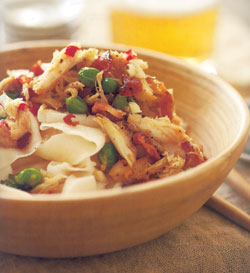
8 ounces sliced bacon
1 large garlic clove, minced
1 large shallot, minced
2 scallions, trimmed and minced
2 lemongrass stalks, trimmed to 8 to 10 inches and grated
3 to 4 red Thai chilies, stemmed, seeded and minced
12 to 16 ounces lump crabmeat
1 cup fresh shelled green peas, or frozen peas, thawed
Fish sauce
Freshly ground black pepper
Bring a medium pot of water to a boil over high heat. Cook the dumpling-wrapper noodles until tender yet firm, about 1 minute. Drain, toss with the oil, and divide among individual soup bowls or plates.
In a wok or large skillet over high heat, stir-fry the bacon until it renders its fat and is crispy, 3 to 5 minutes. Add the garlic, shallot, scallions, lemongrass and chilies, and continue to stir-fry until golden, about 5 minutes. Add the crabmeat and peas and toss well. Season with the fish sauce and pepper to taste, and divide among the servings of noodles. Serve hot.
Makes: 6 servings
Note: Widely available fresh or frozen, lemongrass gives a delicious lemony flavor to any dish without the tanginess associated with lemons. To trim, remove the bruised outer leaves, root ends and tough green tops before using. After trimming, about 8 to 10 inches of the stalk (the creamy white and light green parts) can be used.
Sweet Soy Base Sauce
1/2 cup water
4 large cloves garlic, thinly sliced
Six 1/8-inch slices peeled fresh ginger
1 teaspoon black peppercorns, crushed
1 cup soy sauce, preferably low sodium
1/2 cup light brown sugar
1/4 cup red or white wine
Combine the water, garlic, ginger and peppercorns in a medium saucepan and bring to a boil. Lower the heat and simmer for 10 minutes.
Add the soy sauce, brown sugar and wine. Turn the heat to high and boil for 2 minutes.
Remove from the heat and let the mixture cool to room temperature.
Strain the sauce through a sieve into a large mixing bowl. Discard the ginger, garlic and peppercorns. Store the sauce in an airtight container in the refrigerator. It will keep for 3 months in the refrigerator.
Singapore Noodles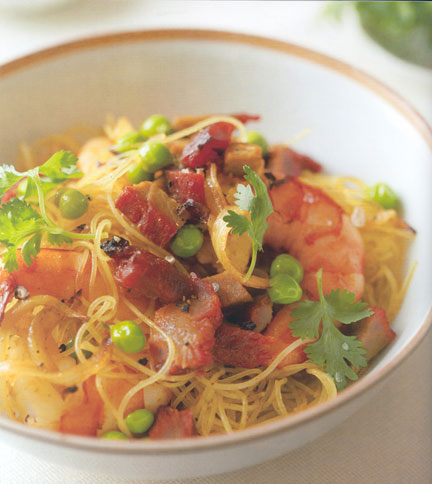
Singapore-style noodles are a favorite in Chinese-American restaurants and are traditionally made using leftover Cantonese roast pork. The dish is lightly seasoned with Indian curry powder, giving the thin rice noodles a beautiful yellow hue. The curry flavor explains the dish's name: Singapore cooking exhibits a significant Indian influence. Stir-fried with small shrimp and peas, this colorful dish can be made ahead of time and very successfully reheated.
Cantonese roast pork can be found in Chinese markets. You'll recognize the long and thick reddish-golden meat strips hanging in the window to entice passersby.
8 ounces dried rice vermicelli, soaked in water until pliable
24 small tiger shrimp, heads removed, peeled and deveined
3 tablespoons vegetable oil
1 small onion, cut into thin wedges
1/2 cup fresh shelled green peas, or frozen peas, thawed
2 teaspoons Indian curry powder
6 ounces Cantonese roast pork or thick slice of ham, diced
1-1/2 tablespoons fish sauce
Kosher salt and freshly ground black pepper
6 sprigs cilantro, trimmed
Bring a pot of water to a boil over high heat and cook the noodles until tender yet firm, about 10 seconds. Use a strainer and tongs to pick up the noodles and transfer them to a bowl. In the same water cook the shrimp until opaque, about minute, and drain.
Heat 1 tablespoon of the oil in a large skillet or wok over high heat. Stir-fry the onion until golden, 3 to 5 minutes. Add the remaining 2 tablespoons of oil, the noodles and peas, and sprinkle the curry powder over the top. Toss well, making sure all of the noodles become yellow. Add the pork, shrimp and fish sauce, and continue to stir-fry until the noodles are heated through, about 5 minutes. Adjust the seasoning with salt and pepper, if necessary, and serve garnished with cilantro.
Soba with Grilled Asparagus and Sea Scallops with Sweet Miso Sauce
In this dish the soba is flavored with Fried Scallions in Oil and topped with grilled asparagus and sea scallops glazed with a sweet miso sauce. During the summer you can grill the asparagus outdoors. The smoky flavor of a wood charcoal fire adds complexity to this substantial meal. While I call for green asparagus, try making the dish with a colorful array of asparagus-green, white and purple. White miso, which is called shiro-miso in Japanese,can be found in health food stores. Smooth rather than grainy miso is preferable for this recipe.

3 tablespoons sugar
1/4 cup sake
3 tablespoons mirin
2 tablespoons rice vinegar
1/3 cup white miso
1 tablespoon finely grated ginger
1/4 cup vegetable oil
10 ounces dried soba noodles
36 medium asparagus spears, woody ends snapped or cut off
18 sea scallops
Kosher salt and freshly ground black pepper
12 walnut halves, lightly toasted and coarsely chopped (see Note below)
In a bowl, whisk together the sugar, sake, mirin and rice vinegar until the sugar is completely dissolved. Add the white miso, ginger and 1 tablespoon of the oil and whisk until well combined. Set the miso glaze aside.
Bring a large pot of water to a boil over high heat and cook the noodles until tender yet firm, about 3 minutes. Drain, shock under cold running water, and drain again.
Heat a well-oiled grill pan over medium heat. Brush the asparagus and scallops with all or most of the remaining 3 tablespoons of oil and season with salt and pepper to taste. Grill the asparagus first until just tender, 3 to 5 minutes total, rolling them about to heat them evenly all around. Divide and top each noodle serving with asparagus. Grill the scallops in the same pan until cooked through and crisp on each side, about 2 minutes per side. Divide the scallops among the servings of noodles, and spoon some miso glaze over each. Serve garnished with toasted walnuts.
NOTE: To toast the walnut halves, put them in a dry skillet over medium-low heat for about 3 minutes, being sure to shake the pan so as not to burn the pieces. Remove from the pan and cool slightly before chopping.
Makes 6 servings.
 Cambodian Cooking
Cambodian Cooking
by Joannes Riviere
Published by Periplus Editions
Grilled Eggplant With Pork
This is a typical dish from the Kampuchea Krom area in the Mekong Delta.
2 slender Asian eggplants
1-1/2 cups ground pork
3 cloves garlic, peeled and chopped
2 small red shallots, peeled and chopped
2 stalks lemongrass, tender inner part of bottom third only, sliced
2 tablespoons fish sauce
1 teaspoon palm sugar or dark brown sugar
1 bunch coriander leaves (cilantro) or sawtooth herb, chopped
Grill the eggplants in a broiler or oven until the skin is black and the flesh is soft. Cut them in half lengthwise, scrape the flesh out with a spoon and chop it roughly.
Heat a wok or skillet and stir-fry the pork, garlic, shallots and lemongrass until golden. Add the eggplant flesh and cook for 2 minutes. Add the fish sauce and the sugar, and mix well. Serve garnished with the chopped coriander leaves or sawtooth herb.
Makes: 4 servings